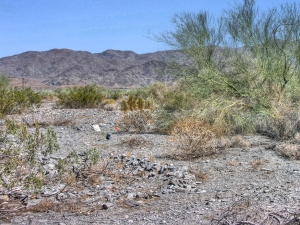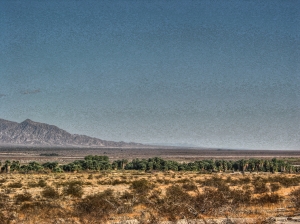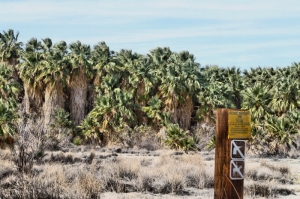

Area: The Bureau of Land Management Dos Palmas Area of Conservation and Ecological Concern (ACEC) is 15,164 acres; CNLM owns and manages approximately 750 acres.
Location: Riverside County, CA
Date Acquired: 1999-2013
Acquisition Type: CNLM owns Dos Palmas Preserve.
Key Habitats: Palm Woodland Oasis, Desert Riparian, Desert Wash and Alkali Desert Scrub
Species of Special Interest to CNLM: Desert pupfish (Cyprinodon macularis), Yuma clapper rail (Rallus longirostris yumanensis), California black rail (Lateralus jamaicensis coturniculus) and Flat-tailed horned lizards (Phrynosoma mcallii).
Introduction
The Center for Natural Lands Management (CNLM) became a partner at the Dos Palmas Preserve in late 1999 during a transition from The Nature Conservancy, who had previously played an active role in both management and acquisition of Dos Palmas lands beginning in 1989 (The Bureau of Land Management (BLM) is the lead partner agency). The Preserve is located within the Dos Palmas Area of Critical Environmental Concern (ACEC), in recognition of the need to protect the valuable natural resources at this location. There are roughly 15,000 acres protected within this ACEC, 750 acres of which are owned and managed by CNLM.
Conservation Significance
 The Salton Sink, in general, is a vast alkali scrubland with harsh dry summers, torrential fall rains and flooding, and cool winters. Thus, the extremes in this area are vast. In addition, the area has been inundated by outpourings from the Colorado River at least five times creating a body of water known as Lake Cahuilla. The current iteration of the lake began in 1905, when an engineering mistake allowed the Colorado River to breach its banks and pour into the sink. It took two years to plug the breach, and the Salton Sea was born. The sea is now mostly fed by agricultural runoff and rainfall, and has no natural inlet or outlet. The Dos Palmas Preserve is on the northeast edge of the sink, bordered by the Orocopia and Chocolate Mountains.
The Salton Sink, in general, is a vast alkali scrubland with harsh dry summers, torrential fall rains and flooding, and cool winters. Thus, the extremes in this area are vast. In addition, the area has been inundated by outpourings from the Colorado River at least five times creating a body of water known as Lake Cahuilla. The current iteration of the lake began in 1905, when an engineering mistake allowed the Colorado River to breach its banks and pour into the sink. It took two years to plug the breach, and the Salton Sea was born. The sea is now mostly fed by agricultural runoff and rainfall, and has no natural inlet or outlet. The Dos Palmas Preserve is on the northeast edge of the sink, bordered by the Orocopia and Chocolate Mountains.
The Dos Palmas Preserve is located near the north-east margin of the Salton Sea and includes a rich mosaic of desert habitats, rare desert wetlands, and important desert washes, including the core marsh, which is a fresh emergent wetland. The focus of protection here includes a native desert fan palm (Washingtonia filifera) oasis, an extensive freshwater marsh and a portion of the Salt Creek. These habitats are critically important for federally endangered species including the desert pupfish (Cyprinodon macularis), Yuma clapper rail (Rallus longirostris yumanensis), rare California black rails (Lateralus jamaicensis coturniculus), and important habitat for a special-status animal, the flat-tailed horned lizard (Phrynosoma mcallii). It provides a significant stopover for neotropical migrants, including the yellow-breasted chat (Icteria virens) and southwestern willow flycatcher (Empidonax traillii extimus). The CNLM Dos Palmas Preserve contains a verdant oasis, rich desert marsh, and desert riparian and desert wash surrounded by a harsh and strangely beautiful desert landscape.
 The Dos Palmas Preserve is located in one of the lowest deserts in North America. The Salton sink is a region of land that is actually spreading, a result of the intersection and twisting of several faults. The Salton Sea has a surface level of 227 feet below sea level, and an estimated 269 below sea level at its deepest point, which is only 18 feet higher than the lowest point in Death Valley (Badwater Basin is 289 feet below sea level). The Preserve is at a bit higher elevation, a whopping 210 feet below sea level.
The Dos Palmas Preserve is located in one of the lowest deserts in North America. The Salton sink is a region of land that is actually spreading, a result of the intersection and twisting of several faults. The Salton Sea has a surface level of 227 feet below sea level, and an estimated 269 below sea level at its deepest point, which is only 18 feet higher than the lowest point in Death Valley (Badwater Basin is 289 feet below sea level). The Preserve is at a bit higher elevation, a whopping 210 feet below sea level.
The Dos Palmas ACEC contains the headwaters of the Salt Creek, a perennial creek that runs through the ACEC (and through two of the CNLM parcels) and into the Salton Sea. This creek is one of the native homes of the desert pupfish. The extensive wetlands and oases that are part of the ACEC are fed by springs, but historically also fed extensively by seepage from the (unlined) Coachella Canal that runs just north of the ACEC. In 1996, the Bureau of Reclamation started the process of lining the canal. Since that time extensive work has been done to mitigate the loss of that seepage. An important part of the mitigation process is to ensure that places like the Core Marsh (CNLM’s primary parcel at Dos Palmas) retains enough water to protect the Yuma Clapper and Black rails that inhabit the marsh.
Our Work
 CNLM works cooperatively to manage the Dos Palmas Preserve and Dos Palmas ACEC with the BLM, the California Department of Parks and Recreation, the California Department of Fish and Wildlife, as well as a number of other smaller partners. Many threats still exist for the Dos Palmas Preserve. An exotic tree, the salt cedar (Tamarix ramossisima), has invaded the wetlands on the Preeserve and threatens them by reducing water availability as well as crowding out the native species. An active salt cedar control program helps to control this species and conserve the important wildlife and ecological values of the Preserve. With the exception of the flat-tailed horned lizards, all the focal species on Dos Palmas are dependent upon a reliable source of water. Currently, work is underway to maintain an appropriate level of water. Decreased flow threatens the Yuma clapper rails and the desert pupfish, and the lining of the Coachella Canal has put the availability of water at risk. Other exotic species, such as the leopard frog (Rana berlandieri), mosquito fish (Gambusia affinis), and several fish species threaten the health of the desert pupfish populations. These threats are challenging, but the unique and exotic nature of the Preserve is worth the challenge.
CNLM works cooperatively to manage the Dos Palmas Preserve and Dos Palmas ACEC with the BLM, the California Department of Parks and Recreation, the California Department of Fish and Wildlife, as well as a number of other smaller partners. Many threats still exist for the Dos Palmas Preserve. An exotic tree, the salt cedar (Tamarix ramossisima), has invaded the wetlands on the Preeserve and threatens them by reducing water availability as well as crowding out the native species. An active salt cedar control program helps to control this species and conserve the important wildlife and ecological values of the Preserve. With the exception of the flat-tailed horned lizards, all the focal species on Dos Palmas are dependent upon a reliable source of water. Currently, work is underway to maintain an appropriate level of water. Decreased flow threatens the Yuma clapper rails and the desert pupfish, and the lining of the Coachella Canal has put the availability of water at risk. Other exotic species, such as the leopard frog (Rana berlandieri), mosquito fish (Gambusia affinis), and several fish species threaten the health of the desert pupfish populations. These threats are challenging, but the unique and exotic nature of the Preserve is worth the challenge.
Public Access
Public visitation is encouraged, with several hiking opportunities available. The ACEC can be accessed via Parkside Dr. off of Highway 111. Drive to the gate where there is a parking lot with bathroom facilities. From here, walk east down the road to the ponds and the oases. No vehicles are allowed past the gate.
Contact
For information about Dos Palmas Preserve or Center for Natural Lands Management, please contact Ginny Short, Preserve Manager at gshort@cnlm.org.

